Table of Contents
On many occasions, we have spoken in these pages of the numerous canallers that frequented the lakes in the years before the opening of the Seaway in 1959. Most of the canallers were either bulk carriers or package freighters and it is understandable that most of what has been written about the canal steamers has concerned them. There were, however, a number of canallers that were designed and built as specialty carriers, and little has appeared in print concerning these ships, even though many of them did survive for several years after the advent of the Seaway system.
Amongst the most interesting of these specialty canallers were the tankers. A number of them were built by British yards in the late 1920s and early 1930s, and they were some of the most handsome canallers ever built, with their beautiful teak pilothouses and towering funnels. It is high time that we devoted some of our attention to them, and we will now set about making up for the fact that we have not done so earlier.
One of the Canadian fleets that operated canal-sized tankers was the British American Oil Company Limited, Toronto. Commonly known as "B-A", this firm had been founded back in 1906 by A. L. Ellsworth, the new company trading as a jobber of lubricating oils and kerosene. B-A, however, was greatly concerned about the quality of products marketed under its name, and so in 1908 it built its first refinery, which was located on the Toronto waterfront. In subsequent years, the company expanded its operations, first through Ontario and into the province of Quebec, and then later into Western Canada. In 1931, B-A opened a refinery at Montreal East, and chartered ocean tankers brought crude oil to it from the wells of Texas. The company made the decision to build a fleet of canal-sized tankers to carry some of the cargoes from the salt-water tankers up to the Toronto refinery and also to distribute the products of the refinery to various lake ports.
Accordingly, early in 1931, British American Oil ordered two canal-sized tankers from the Furness Ship Building Company Ltd., and the vessels were built at Haverton Hill-on-Tees, England, as the shipbuilder's Hulls 199 and 200. Enrolled as C.157039 and C.157343, they were named, respectively, BRITAMOIL and BRITAMOLENE, these names incorporating an abbreviation of the company's name with a reference to their owner's involvement in the petroleum industry (as in "oil" and "gasolene").
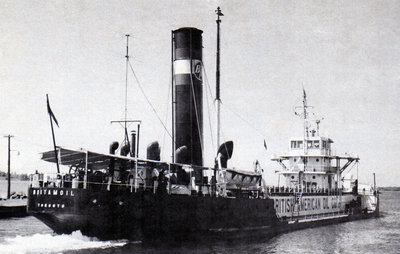
BRITAMOIL is upbound above the Canadian Soo Lock in this August 21, 1957 photo by the editor.
The steamers, exact sisterships, were 250.0 feet in length, with a beam of 43.2 feet and a depth of 17.9 feet, and their tonnage (which was the same for each ship) was 1931 Gross and 1099 Net. Each vessel was propelled by a single screw which was driven by a triple expansion engine with cylinders of 17. 28 and 46 inches, and stroke of 36 inches. Steam at 180 p.s.i. was provided by one Scotch boiler. The machinery was constructed for the tankers by the North Eastern Marine Engineering Company Ltd. of Newcastle, England.
BRITAMOIL was launched on Thursday, May 14, 1931, while BRITAMOLENE hit the water of the River Tees on the following Tuesday, May 19th. According to a "Canadian Railway and Marine World" report in its July 1931 issue, "both ships were launched in a completely finished condition, except for their propelling machinery, and were built in the remarkably short period of thirteen weeks. Immediately after their launching, they proceeded to the Tyne to receive their propelling machinery. BRITAMOIL completed her sea trials June 4, BRITAMOLENE completing hers June 19. After the sea trials, the ships left for Montreal. Both ships are being operated under the management of W. Gordon Smith, Marine Superintendent. The officers are: BRITAMOIL - H. C. Burns, captain, and J. Sweeting, chief engineer; BRITAMOLENE -W. F. Garrett, captain, and G. Bragg, chief engineer.
"The following description applies to each ship. They are tankers of the single deck type, with poop and forecastle, and expansion trunk over the range of oil compartments, and were built to Lloyd's 100 A-l class for carrying petroleum in bulk for service on the Great Lakes... A deadweight of about 2,800 tons will be carried on the load draft. Five main oil cargo tanks are arranged each side of the centre line, making ten in all, the upper portion of each tank forming the expansion trunk. The pump room is fitted forward, and an oil fuel bunker with steam heating arrangement is fitted forward of the machinery space.
"Water ballast spaces are provided in the fore and after peaks, and feed water in the double bottom underneath the machinery space. Steaming out and fire extinguishing apparatus is fitted to the oil cargo and fuel tanks. A cargo hold is fitted forward, served by a hatch with two two-ton derricks. A powerful steam windlass is fitted on the forecastle deck, with a 7 x 10 inch mooring winch; a similar winch is fitted aft and two on the upper deck forward for mooring purposes. The steam steering gear, fitted aft, is controlled by rods from the wheelhouse amidships and the poop deck aft.
"The wheelhouse is of teak and is specially designed with a large area of clear glass to give good visibility for navigation of the canals . The captain is provided with a well furnished suite in separate deckhouse, consisting of sitting room and bedroom finished in dull plain oak, and with private bathroom adjoining. A tastefully furnished owner's room, finished in oak, is provided, with private lavatory adjoining. The officers are berthed in a deckhouse amidships, ample messroom and store room and lavatory accommodation being provided. A refrigerated chamber is fitted aft for ship's use. A complete electric light installation has been carried out.
"The cargo pumping installation consists of two horizontal duplex cargo pumps, capable of dealing with different classes of oil at the same time, and one horizontal ballast pump. The propelling machinery, located aft, consists of a... triple expansion engine with multitubular marine type boiler. The ships were built under the superintendence of the owner's resident surveyor, John Carmichael, of Middlesbrough. The BRITAMOIL arrived at Toronto on June 25, and was followed by the BRITAMOLENE."
Each ship's forecastle and quarterdeck were raised a full deck-height above the spar deck but were flush with the top of the trunk. There was a short closed rail atop the forecastle at the stem, but the rest of the forecastle, the upper and lower decks, and the poop were equipped only with an open rail. The after cabin was completely plated in to provide protection from the seas, and to give more space, and there was no deckhouse aft at all. The very tall stack, surmounted by a prominent cowl, rose (with a considerable rake) out of the enclosed after cabin, and it was surrounded by a virtual forest of large ventilators. A tall mainmast was stepped just forward of the stack.
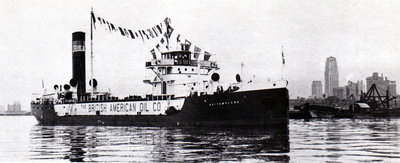
BRITAMOLENE, dressed for Dominion Day, is inbound at Toronto's Cherry Street on July 1st, 1932. Photo by J. H. Bascom.
As mentioned, the officers were accommodated in a large, squarish deckhouse which formed the lower level of the triple-deck bridge structure. The bridge was located about a third of the way down the deck. The master's quarters were in the texas, being on the second deck of the bridge structure, and this cabin was surrounded by a large open deck area with a closed steel rail at its forward end. On the bridge deck was the beautiful teak pilothouse, with its large windows, and with its two forward corners angled off. For navigation in the canals, very long bridgewings were provided, and their extreme cambered length was supported by means of steel braces which were angled downward and inward to the texas deck. A very short foremast was located immediately abaft the pilothouse, rising out of the texas cabin.
The steamers were painted very attractively. The hulls were black, while the trunk, forecastle rail and cabins were white. The company's name was lettered down the sides of the trunk in a bluish-green shade (later a true green), while the deck trim was dark green. The teak pilothouse was varnished. The stack was black with a wide white band between two slightly narrower bands, the upper one green and the lower one red, and the letters 'BAO' appeared in red on the white band. The ventilators surrounding the stack were originally white with green trim inside the cowls, although the ventilators very soon became all green, both inside and out.
BRITAMOIL and BRITAMOLENE went into regular service as soon as they arrived on the lakes. The sisterships, each capable of carrying 22,000 barrels of cargo, operated very successfully and kept busy despite the effects of the Great Depression which were making themselves felt by the lake shipping industry . The poor business conditions had much less of an effect on the rapidly developing petroleum industry than they had on other parts of the economic community, and tankers were much in demand.
In fact, BRITAMOIL and BRITAMOLENE proved to be so successful that the British American Oil Company soon ordered two similar tankers from the same shipbuilders. Built at Haverton Hill-on-Tees, as the yard's Hulls 209 and 212, they were christened, respectively, BRITAMOCO and BRITAMLUBE, and they were enrolled as C.157359 and C.157353. Despite the order of their Hull Numbers, the vessels were completed in reverse order, and BRITAMLUBE was the first of the new pair to be commissioned. They were built under the supervision of surveyor John Carmichael, and he was assisted by J. Sweeting, who had been the first regular chief engineer aboard BRITAMOIL.
The two newer vessels were exact sisterships, but they differed slightly from the earlier pair of steamers. They had exactly the same engines and hull dimensions as did BRITAMOIL and BRITAMOLENE, but the new pair had tonnages of 1932 Gross and 1085 Net, and they also were equipped with two boilers each instead of just one. BRITAMLUBE and BRITAMOCO always could be differentiated readily from the older pair in that their stacks were noticeably shorter, although still very tall.
BRITAMLUBE was launched on Tuesday, March 22, 1932, her sponsor on that occasion being Miss Carmichael, the daughter of the resident surveyor. BRITAMOCO did not enter the waters of the River Tees until Saturday, May 14, 1932 (one year to the day after the launch of BRITAMOIL). Each of the new steamers was built complete in the short period of only twelve weeks from the laying of the keel, and each was taken to Newcastle for the fitting of her machinery. BRITAMOCO completed her sea trials on June 3rd and arrived safely at Montreal on June 18th. Her commander for the run across the Atlantic was Capt. Clark, who had also commanded BRITAMOIL for the deep-sea portion of her delivery trip. It is reported that Capt. Anderson and a Canadian crew took over BRITAMOCO at Montreal, and that she sailed from that port on June 19 with a cargo of 16,000 barrels of crude oil, arriving at Toronto on June 21, 1932.
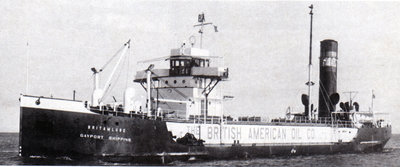
It was the summer of 1951 when the camera of J. H. Bascom caught BRITAMLUBE inbound at the Toronto Eastern Gap.
While it is true that the effects of the Great Depression were not felt as severely in the petroleum industry as elsewhere, the summer of 1932 found the British American Oil Company with four brand new tankers and not enough work to keep all of them busy. For some reason, probably relating to operating costs, BRITAMLUBE was the odd ship out, and she spent most of the autumn of 1932, her first in commission, laid up along the north wall of the Toronto ship channel. The next year saw her back in service, however," and she and her three sisters operated consistently, year after year, for the rest of their careers in B-A colours.
Although the British American Oil Company Ltd. was the real owner of all four of the new tankers, the company chose to have each of the steamers operated by a separate corporate entity, each of them incorporated under the Dominion Companies Act as a private company with authorized capital of $50,000 in $100 shares, and with offices in Halifax, Nova Scotia. Thus came into existence Britamoil Ltd., Britamolene Ltd., Britamlube Ltd., and Britamoco Ltd., which were to remain active for some fifteen years. The names of these individual firms, however, were never actually painted on any of the tankers.
Some of the men who served with the British American Oil fleet in its early years remained associated with the company for many seasons. Capt. Wilfred Garrett, who was the first lake master of BRITAMOLENE, served the fleet until his retirement in 1964. W. Gordon Smith, who was the first and only marine superintendent of the B-A fleet, retired as marine manager in 1967. As well, all four of the original near-sister tankers lasted with the fleet for many years, none of them ever falling victim to serious accident.
Only one major change in colours was ever made to the four tankers whilst in B-A ownership. In latter years, the letters 'BAO' were removed from the tankers' stacks, and in their place appeared a new design. Centred over both the white and red bands was mounted a circular "yin-yan" device, the left half green and the right half red, divided from upper right to lower left by a curved white diagonal. The letters 'B' and 'A' appeared in white, the 'B' on the green side and the 'A' on the red half.
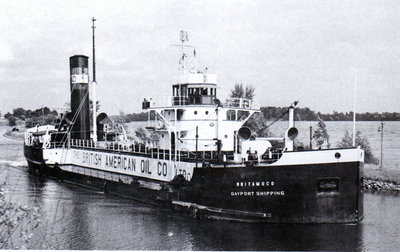
The late James M. Kidd took this scenic view of BRITAMOCO passing the Long Sault Rapids in the St. Lawrence River on July 20, 1951.
In 1946, British American Oil decided to divest itself of the ownership of its lake tankers, and the four sisters were sold to Gayport Shipping Limited. There was little change in the tankers' operations, however, for they were immediately chartered back to B-A and remained in the company's service until 1959. The change in ownership officially took place in April of 1946, and from that point onward, the vessels carried the name of the new owner in small white letters under the ships' names on the bow.
In the early 1950s, all four of the tankers were given new pilothouses, the teak structure of the old cabins having fallen victim to the ravages of the elements. The new houses were large, square, steel cabins, with five large windows across the front. The two wing windows were curved around the corners of the structure, while the three centre windows had lower sections extending down almost to the bridge deck in order to provide the greatest possible visibility, especially when canalling or docking. The first of the sisters to receive her new pilothouse was BRITAMOCO, which saw considerable coastal service, and which had operated for a while with her old teak pilothouse shored up by large, angled wooden beams.
In fact, BRITAMOCO was no stranger to salt water, for during the winter of 1953-1954. she had been taken south to operate between Aruba, in the Netherlands Antilles, and Cartagena, Colombia. As well, BRITAMOCO spent much of her time during the 1950s operating on the St. Lawrence River and the east coast, appearing on the lakes only infrequently during that period. At this time, the B-A. insignia on her stack were painted out and the company's name was removed from the sides of her trunk.
With the opening of the St. Lawrence Seaway in 1959, the British American Oil Company decided to give up the operation of the canal-sized tankers. Not only were they no longer economical to operate, but as well the company no longer required small tankers to serve its Toronto refinery. The plant had been located on the north side of the Keating Channel, between the bridge and the mouth of the Don River, and only small vessels could dock there. Although portions of the plant continued to function for a number of years, even after the company became known as Gulf Canada Limited, the docking facilities and freight sheds along the north side of the channel were removed during the construction of the Gardiner Expressway and the relocation of Lakeshore Boulevard to a point closer to the water.
Accordingly, on July 1st, 1959, the four tankers were sold by Gayport to the Hall Corporation of Canada, Montreal, which was in the course of developing a fleet of tankers to supplement its bulk cargo operations. The four steamers were immediately renamed, with BRITAMOIL becoming (b) ISLAND TRANSPORT (I), BRITAMOLENE being renamed (b) WAVE TRANSPORT, BRITAMLUBE becoming (b) BAY TRANSPORT (I), and BRITAMOCO being rechristened (b) GULF TRANSPORT. The ships retained their black hulls, and their white trunks, forecastle rails, and cabins, but their stacks would eventually become black with the usual Hall insignia, the white "wishbone" and letter 'H'.
It had always been the custom of the B-A fleet to lay up all four of the sister tankers at Toronto each winter, and true to form the four returned to Toronto during the winter of 1959-60, despite the change in their ownership. As they lay in the Toronto turning basin that winter, their very tall stacks were cut down to a more fashionable length. It was not until this operation had been performed that the ships received their Hall stack colours. The work obviously had been planned during the 1959 season, and so no effort was made to apply the new colours until the shortening of the funnels was completed, and instead the B-A stack insignia were simply painted out for the duration of the 1959 navigation season.
At the same time that her stack was cut down, GULF TRANSPORT received an additional "improvement", in that she lost her trunk. Her sides were built up flush with the upper deck and wing tanks were fitted into the newly created hull space. This operation undoubtedly increased GULF TRANSPORT'S economic viability, with her tonnage increased to 2174 Gross and 1218 Net, and her depth to 25.4 feet. However, the reconstruction left the ship looking very much the part of the "ugly duckling". The addition of the wing tanks made her totally flush-decked and very "flat" looking. Only short sections of fender strake were placed on her sides, and accordingly her hull showed every scrape that she suffered in canalling or docking, and the side plates were usually well banged and "bucketed". In addition, during the rebuilding, the ship's derrick posts (used to lift the cargo hoses) were moved from the bow to a location abaft the bridge so as to serve the new location of the pumping equipment, and this move left the steamer's forward area rather bare.
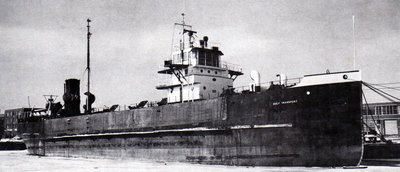
It is February 22, 1960 as GULF TRANSPORT, her stack freshly cut down, has her wing cargo tanks installed at Toronto. J. H. Bascom photo.
For some reason, GULF TRANSPORT was the only one of the sisters ever to receive this reconstruction. Why it was never done to the others, we have no idea, but it did manage to prolong somewhat the life of GULF TRANSPORT in Hall service. The others did not enjoy many seasons of Hall operation, and were sold off within a few years of their acquisition.
ISLAND TRANSPORT, which had been lying idle at Port Weller, was sold on April 30, 1963, to D'Alesio and Castaldi of Livorno, Italy, and she was renamed (c) ELBA. Refitted by Port Weller Dry Docks, she sailed off to salt water under her own power, leaving Port Weller on May 9, 1963. In 1969. she passed to the ownership of Piero, Giorgio and Mario Castaldi, of Livorno, and she latterly served as a bunkering tanker in the harbour at La Spezia, Italy. Eventually, however, the advancing years got the better of her, and ELBA was dismantled at La Spezia in 1981.
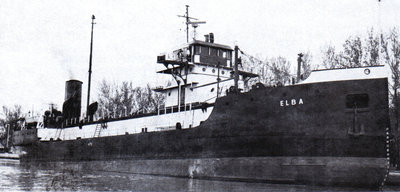
On May 9, 1963, ELBA, the former ISLAND TRANSPORT (I), cleared Port Weller bound for Italy. Photo by the late Paul Sherlock.
The next of the sisters to be sold out of the Hall fleet was WAVE TRANSPORT, which was sold in August of 1963 to Florence Nav. S.A., Panama. Transferred to Panamanian registry and renamed (c) FLORENCE B., she was fitted out at Port Weller, sailing from that port on August 29th, bound for salt water. In the autumn of 1966, she was purchased by the Western Shipping Company Inc. of Panama, which renamed her (d) CAPTAIN THEO. In 1973, the steamer was sold to Transportes Maritimos y Fluviales S.A., of Ecuador, and she was renamed (c) RIO DAULE. She was finally sold for scrapping, and she was delivered to her final owner, Jorge Naula, at Guayaquil, Ecuador, in June of 1982.
The third of the tankers to be sold for salt water service was BAY TRANSPORT which had spent the 1963 season in idleness at Montreal. On May 4, 1964, she was sold to the same buyers that took ISLAND TRANSPORT off the lakes, namely Gaetano D'Alesio and Ettore Castaldi, of Livorno, Italy. She sailed out of Montreal under her own power later that month, bound for Italian waters. Once on salt water, she received certain modifications to enhance her unloading capabilities, permitting her to service a variety of local facilities. In 1969. she was acquired by P. G. & M. Castaldi, of Livorno. It is possible, although unlikely, that she is still in service somewhere in the Mediterranean, for we have never received a report of her scrapping.
The rebuilt GULF TRANSPORT served the Hall fleet for a full decade after her reconstruction, and in 1969 her ownership was transferred to the Hall Corporation (Shipping) 1969 Ltd. Back in 1964, she had been involved in an interesting occurrence when, on June 3rd, she became the first Canadian merchant vessel to fly the then-new Canadian flag in place of the old Red Ensign. What was strange about the incident was that the new flag was not officially adopted by Canada until February of 1965.
Finally, in the autumn of 1970, GULF TRANSPORT reached the end of her usefulness in the Hall fleet, and she too was sold for off-lakes service. On Saturday, October 24, 1970, GULF TRANSPORT passed down the Welland Canal for the last time, bound light for Quebec. On October 31st, she was sold to the Compagnia Armatoriale Siculo Adriatica/Cisternia Azionaria Sicula Adriatica S.P.A., of Italy. Before she cleared Quebec City, however, she was transferred to the ownership of Cia. Armatoriale Palermitana "Cabrilla" S.A., also of Italy. She eventually sailed from Quebec and was renamed (c) NONNA VALERIA during the course of her delivery voyage to Italy. Despite the fact that she had been the last of the four sisters to serve in the Hall fleet, this steamer proved to be the first of the four tankers to go under the breaker's torches, and she was scrapped at La Spezia, Italy, in 1974.
The four British American Oil Company canal tankers enjoyed long lives, longer than many of the other Canadian canallers would have. They served well, not only on the lakes but also on salt water, a testimony to the quality of their design and construction, and to the manner in which they had been operated and maintained during their many years of B-A service.
Previous Next
Return to Home Port or Toronto Marine Historical Society's Scanner
Reproduced for the Web with the permission of the Toronto Marine Historical Society.